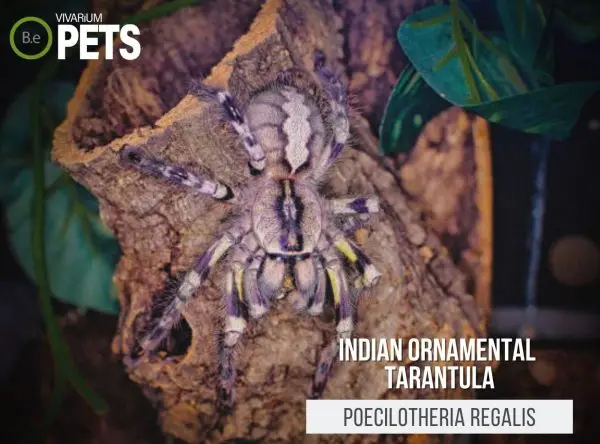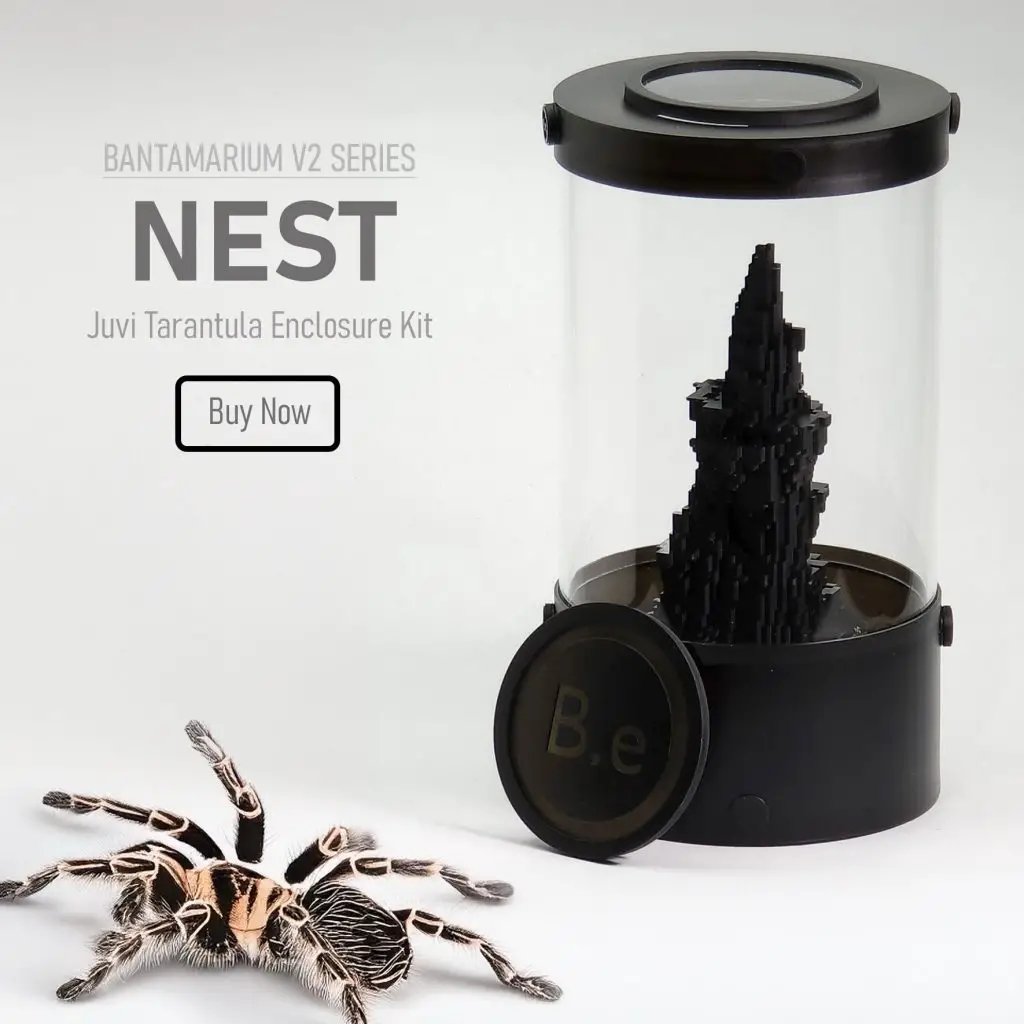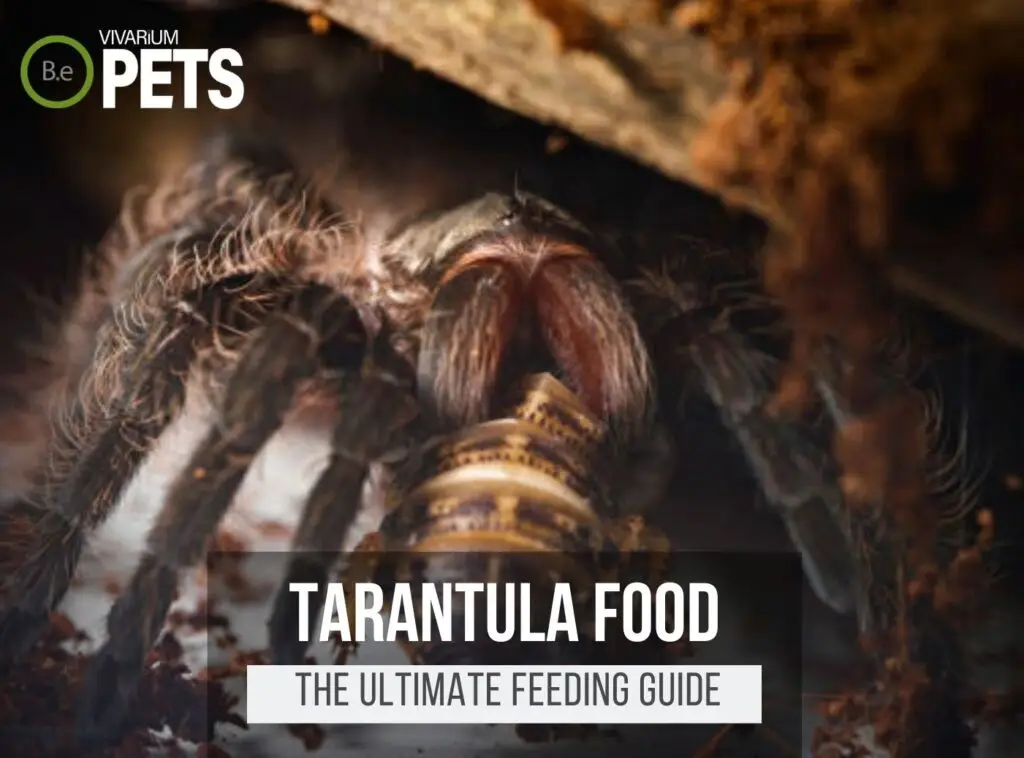The Indian Ornamental Tarantula is one of the most exotic types of pet tarantulas you will ever run across.
In this comprehensive care guide, we discuss all the key aspects of caring and providing for Poecilotheria regalis.
From selecting the right enclosure to feeding this arachnid, handling tips, and potential health problems.
Join us to learn everything you need to know about this fascinating species so you can provide the best home for them!
Table Of Contents:
ToggleWhat Are Indian Ornamental Tarantulas?
Poecilotheria regalis is a species of tarantula from the family of Theraphosidae, a family found mainly in the southern part of India.
The name “Indian Ornamental Tarantula” comes from their beautiful appearance and the fact that they are native to India.
They are a fascinating species and an unusually unique choice for arachnid enthusiasts.
Create the perfect home for your arachnid with our Customizable Spider Enclosure Kits, designed to meet all their habitat needs.
What Do Indian Ornamental Tarantulas Look Like?
Indian Ornamental Tarantulas typically can range from 4-5 inches in size with females typically growing slightly larger.
Most have a unique yellow and black coloring, though some can be a faint pink or purple.
They usually have a silvery-blue shine on their legs, and they have two sets of four eyes.
The eyes have an unusual hexagonal shape to them and are often surrounded by white markings.
Their abdomen is divided into two parts, with the upper part being a darker color while the lower part is lighter.
They also have fangs that can be used to both catch prey and defend themselves.
Additionally, Poecilotheria regalis also has a unique defensive mechanism.
Unlike spiders that use webs, this species has specialized barbed setae around their back legs and the side of their abdomen.
When threatened, these setae can be used to create a loud hissing sound, often deterring potential predators.
Benefits Of Using Indian Ornamental Tarantulas
Having a Poecilotheria regalis as part of a vivarium makes a great addition to any home.
These beautiful arachnids make fascinating pets and are one of the few species that truly react to their environment and respond programmatically to light.
Not to mention, they have a unique appearance with their distinct colors and patterns.
Their ability to traverse and interact with their space means you can create a truly unique and enjoyable experience for them in their environment.
Indian Ornamental Tarantulas are also very hardy and resilient species, thriving in a wide variety of environments along with other creatures in the webs they inhabit.

Indian Ornamental Tarantula Facts
Poecilotheria regalis are beautiful, vibrant arachnids with a temperament that ranges from shy and skittish to bold and fast-moving.
They typically eat small insects in their natural environment and have an average lifespan of several years.
Unlike other tarantulas, they also present a unique opportunity for captive breeding as no special burrow is required for egg deposition.
Habitat
These spiders originate from India, mainly living in deciduous forests and mountainous regions of the country.
Its natural habitat consists of moist soil, tree bark, and decaying leaves.
This specific species can be found in the Vellore district of Tamil Nadu, the Indian states of Srikakulam in Andhra Pradesh, Karnataka, Tamil Nadu, Odisha, and Telangana.
These spiders are endemic to southern India and can be found in the Western Ghats mountain range.
They usually inhabit tree holes, with trees providing the humidity they need to survive.
Indian Ornamental Tarantulas prefer hidden spots, away from direct sunlight.
Interestingly enough, they don’t need much water to survive, only moist air!
Replicate their natural habitat perfectly with our bioactive species-specific soil mixes, designed to provide the ideal moisture and organic content for your spiders.
Diet
Poecilotheria regalis are mainly carnivorous and eat a varied diet of insects such as crickets, cockroaches, moths, and other spiders.
They may also feed on small vertebrates, such as lizards, frogs, and rodents in the wild.
Given they are nocturnal, the Indian Ornamental Tarantula will hunt and forage for food mainly at night.
During the day, they may feed on carrion or passively feed on the food that is available near their burrows if they can’t hunt.
The species generally consume more food during the warmer months of the year and may even become cannibalistic when there’s a lack of food.
When sufficiently satiated, the species may hide any remaining food in their burrows or any other spots near their habitats.
Temperament
Poecilotheria regalis may initially be skittish, but with proper care and handling, they can develop into rather calm and docile pets.
When kept with other tarantulas, these spiders can exhibit aggressive behavior, so it is best to keep them in separate enclosures, or at least keep the enclosure well-maintained.
When it comes to interaction with humans, an Indian Ornamental Tarantula is generally not aggressive, but can still run away if startled.
It is also good to note that tarantulas can be easily intimidated by large animals such as dogs, so it is best to keep them away from these pets.
Lifespan
Poecilotheria regalis has an average lifespan of 3-5 years in captivity – but a female can live up to 8 years with good care.
These arachnids usually reach adult size within a year or two and then their growth rate slows considerably.
The life cycle of an Indian Ornamental Tarantula consists of a few stages: egg, spiderling, subadult, and adult.
Each stage has its own set of characteristics and requirements. The egg stage occurs when the female lays a batch of eggs.
The spiderling stage is when the eggs hatch and they begin to feed and grow.
Subadults are when they become larger and adults when they molt and reach their final size.
They reach maturity when their reproductive organs develop and they are ready to find a mate to reproduce.
Breeding
Indian Ornamental Tarantulas mate in a fascinating way known as ‘dance courtship’.
During this process, the male and female tarantula come together in an intricate courtship ritual.
The male approaches the female from behind, then the female will raise her front legs and quiver in a circle.
This signals to the male that she is ready and willing to mate.
As the male continues to approach, the female will bob her abdomen up and down between steps.
The male begins by tapping the female’s abdomen and legs with his palps, to alert her that he is ready to mate.
This behavior continues until the male grabs the female from behind and inserts spermatophores into the female’s epigyne.
After mating occurs, the female will lay her eggs in a silken tube that she builds.
Fortunately, Poecilotheria regalis are long-term pets and will reproduce relatively slowly.
This means you won’t be swamped with baby spiders anytime soon!
However, it is always good to be prepared, so consider rehoming some of the spiderlings when they become available.
Where To Find Indian Ornamental Tarantulas
Finding an Indian Ornamental Tarantula in the wild is not an easy task as it is found in fairly small areas of India.
However, it is something that experienced tarantula enthusiasts have the potential to do.
It involves a great deal of patience, research, and knowledge of the species’ behavior and habitat.
If you are interested in looking for one in the wild, it is wise to seek legal advice and permission to do so.
For those wanting to purchase Poecilotheria regalis, it is best to seek out a licensed pet store or reputable specialist breeder.
Since they are not typically bred in large numbers, they are rather hard to come by and may be quite expensive.
It is also good to look for specimens that are well-cared for and healthy.
Reputable vendors will often provide a guarantee of health, as well as advise customers on proper care for the species.
Indian Ornamental Tarantula Care
To provide the best care for Poecilotheria regalis, you need to select the right enclosure & accessories and ensure an appropriate environment with the correct temperature & humidity.
Ideally aim to use an effective terrarium substrate, and feed your tarantula correctly with appropriate foods.
Furthermore, practice safe handling techniques, and be aware of potential health problems.
Tank Requirements
When it comes to providing the ideal tank for your Indian Ornamental Tarantula, there are several key factors to consider.
The tank should have a well-ventilated and enclosed environment, with plenty of options to hide and climb.
The ideal vivarium type is a glass terrarium measuring at least 15 gallons; although larger tanks can be used.
Be sure to also maintain the right water parameters, such as a slightly acidic pH (6-7.5) with low to moderate hardness.
Appropriate temperature and humidity levels should range from 75-85°F and 60-70%, respectively.
The best substrate to use would be a 3:1 mix of coco fiber soil and peat moss for a moist burrowing environment.
Terrarium lighting should be provided in the form of a UVB bulb for 12-14 hours on one side of the enclosure for basking.
What Do Indian Ornamental Tarantulas Eat?
Feeding your Indian Ornamental Tarantula can be simple and fun.
They prefer to eat live insects, including crickets, cockroaches, mealworms, and waxworms.
We recommend you feed the tarantula 4-5 insects every two weeks, but this amount can be adjusted depending on the size and age of your spider.
It’s essential to choose the right size of prey for your spider. The insect should be no longer than the width of the spider’s body.
It’s also worth noting that Poecilotheria regalis may enjoy a treat such as fruit flies, small fish, or beetle larvae every once in a while.
These treats should only be offered occasionally and never comprise the main part of their diet.
Finally, it’s vital to provide a shallow water dish for your spider to help them stay hydrated.
Refresh the bowl once a day, or as necessary.
If you’re looking for a more detailed approach to feeding these arachnids, be sure to check out my ultimate DIY tarantula food guide. I give a more in-depth explanation of the best foods and my favorite recipe.
Best Tankmates For Indian Ornamental Tarantulas
Indian Ornamental Tarantulas are solitary creatures, so they do not require any tankmates to be kept with them.
However, for those who have extra space or want to create a natural ecosystem, it is possible to keep other species of animals with them.
One of the best tankmates for Poecilotheria regalis is a small, burrowing species of invertebrates such as African giant millipedes and other giant millipedes.
These animals can cohabitate in the same enclosure and will not compete with the tarantula for food or other resources.
Furthermore, these invertebrates will help to break down waste in the enclosure, allowing the spider to remain healthy and cared for.
In addition, pet isopods and springtails can be kept with P. regalis.
Make sure to research any potential tankmates thoroughly beforehand, as these species can be harmful or territorial and could cause harm to your tarantula.
Additionally, it is best to choose species that have similar requirements for temperature and humidity to ensure a stress-free environment for both animals.
Conclusion
Caring for an Indian Ornamental Tarantula requires a lot of knowledge, attention, and responsibility.
If you follow these steps, you will set up an appropriate environment and create a loving home for your pet.
Remember, being well-informed about the specific needs and requirements of Poecilotheria regalis is crucial for the successful and long-term care of these amazing creatures.
Create the ideal habitat for your arachnids with our species-specific soil mixes and Spider Enclosure Kits. These products provide everything you need for a thriving spider habitat.







